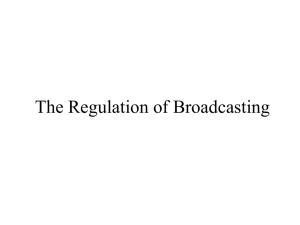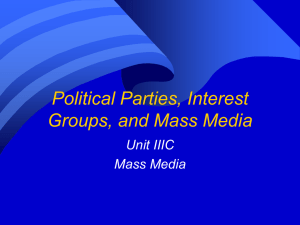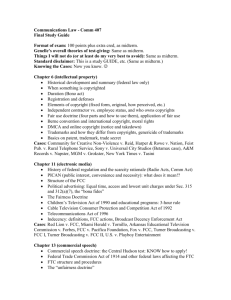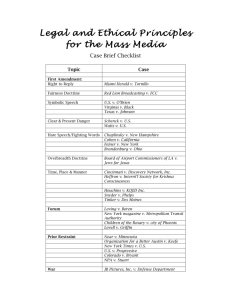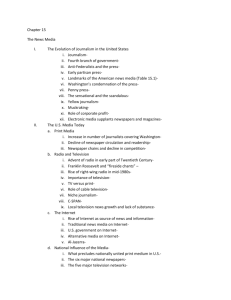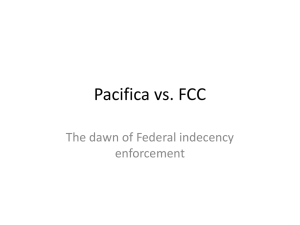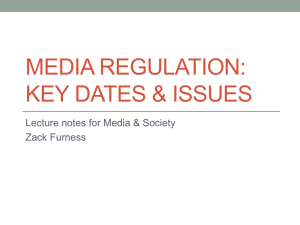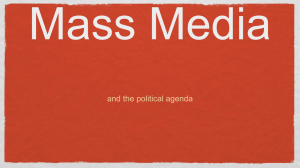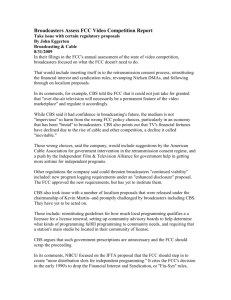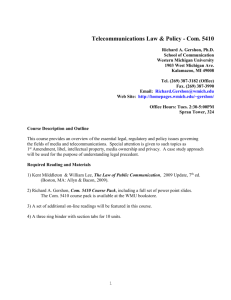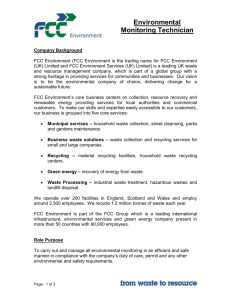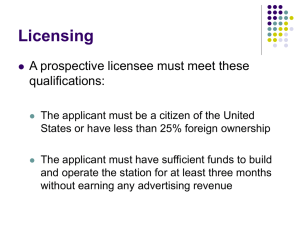Midterm Test and Answers
advertisement
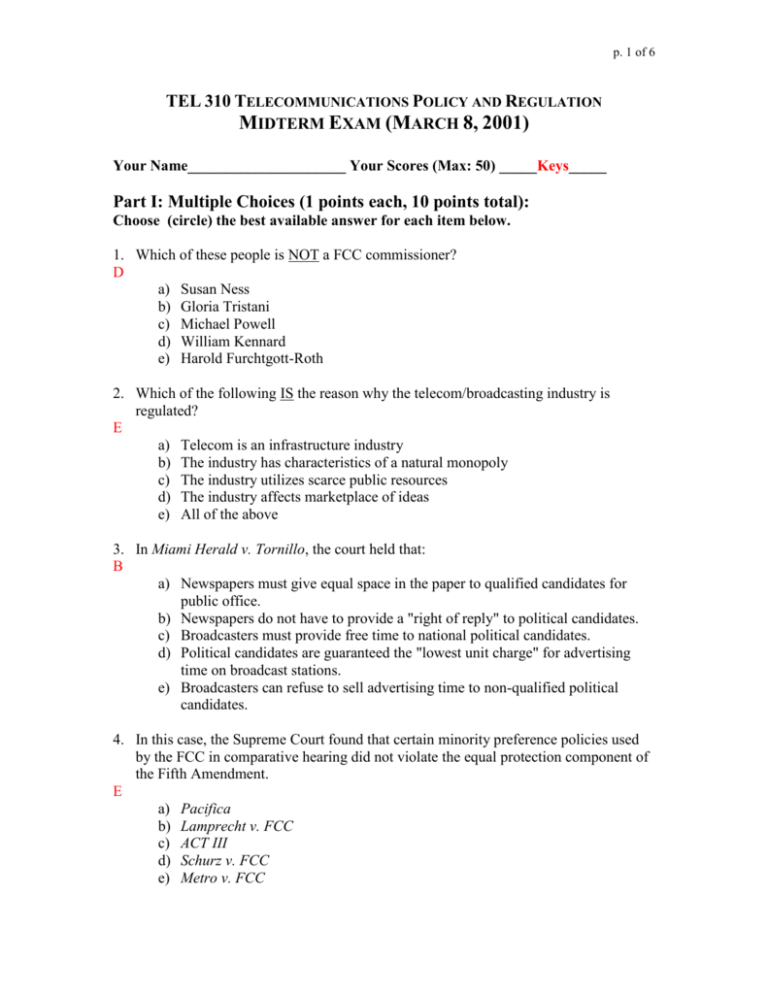
p. 1 of 6 TEL 310 TELECOMMUNICATIONS POLICY AND REGULATION MIDTERM EXAM (MARCH 8, 2001) Your Name_____________________ Your Scores (Max: 50) _____Keys_____ Part I: Multiple Choices (1 points each, 10 points total): Choose (circle) the best available answer for each item below. 1. Which of these people is NOT a FCC commissioner? D a) Susan Ness b) Gloria Tristani c) Michael Powell d) William Kennard e) Harold Furchtgott-Roth 2. Which of the following IS the reason why the telecom/broadcasting industry is regulated? E a) Telecom is an infrastructure industry b) The industry has characteristics of a natural monopoly c) The industry utilizes scarce public resources d) The industry affects marketplace of ideas e) All of the above 3. In Miami Herald v. Tornillo, the court held that: B a) Newspapers must give equal space in the paper to qualified candidates for public office. b) Newspapers do not have to provide a "right of reply" to political candidates. c) Broadcasters must provide free time to national political candidates. d) Political candidates are guaranteed the "lowest unit charge" for advertising time on broadcast stations. e) Broadcasters can refuse to sell advertising time to non-qualified political candidates. 4. In this case, the Supreme Court found that certain minority preference policies used by the FCC in comparative hearing did not violate the equal protection component of the Fifth Amendment. E a) Pacifica b) Lamprecht v. FCC c) ACT III d) Schurz v. FCC e) Metro v. FCC p. 2 of 6 5. Which of the following is NOT protected by the First Amendment? C a) Television violence b) Indecent broadcast c) Obscenity d) A television program rated TV-MA e) None of the above 6. Which of the following IS correct? D a) The FCC was born in the Progressive era. b) PICON stands for "Public interest and Convenience". c) Krattenmaker's definition of public interest includes competition, diversity and fairness. d) Before granting an application to build, modify, renew or sell a station, the FCC is required by law to determine first if grating it would serve the public interest. e) The FCC can adopt regulations without first notifying and seeking comments from the public. 7. Which of the following FCC regulations is currently effective? B a) Radio format regulation b) Equal time rules (for political candidates) c) Fyn/Syn rules d) Prime time access rules e) Fairness Doctrine 8. Which of the following statement about broadcast regulation in the aftermath of the 1996 Telecom Act is NOT true: D a) There is no national radio ownership limit. b) Radio/TV cross-ownership rules are relaxed. c) V-chip is required to be installed in all new TV sets manufactured since 2000. d) Gender preference can no longer be used as a criterion in comparative hearings. e) Comparative hearing is not to be used when an applicant is incumbent. 9. Which of the following industries is NOT under the regulatory authority of the FCC? E a) Telephony b) Radio broadcasting c) Cable television d) Wireless communications e) The Internet p. 3 of 6 10. Broadcasters MUST abide by the following: A a) Airing indecent materials only between 10 pm - 6 am. b) Presenting programs about important local issues. c) Broadcasting three hours of children's programming each week. d) All of the above e) None of the above Part II: Identification and Explanation (5 points each, 20 points total) Define each of the following items and then briefly discuss its significance to Telecommunications Policy. Be sure to list four descriptions in the definition of each item. 1. NTIA P. 21 2. Renewal expectancy P. 94 p. 4 of 6 3. Children's Television Act of 1990 P. 210 and subsequent development as in the 1991 and 1996 guidelines 4. Multiple ownership rules P. 307 and notes for recent rules p. 5 of 6 Part III: Essay Questions (10 points each, 20 points total) Read carefully: 1. Answer both questions here (Sorry, no options). 2. Make sure you are responsive to all the points that the questions ask for. 3. Write in complete sentences --- not just outlines or bullet points. To help organize your thoughts, I recommend that you outline each essay before you begin writing it. In addition, I encourage you to use subheads or numbering points in your essay (making it easier for me to find your answers). 4. Use the space on the back page if you need more. Questions 1: Various courts have argued that the unique characteristics of the broadcast media justify a different First Amendment standard applicable to broadcast, a standard based on the notion of "broadcasters as public trustees". First, what is the "public trustee" model of broadcast regulation? Second, according to the courts in Red Lion and Pacifica, what are the characteristics that distinguish broadcast from other media types? What rules were justified in the two cases respectively? Finally, if similar rules (as litigated in the above two cases) are applied to the Internet, do you think they could hold up to the First Amendment test? Why or why not? 2 points --- Definitions of the model 3 points --- Characteristics: Scarcity, pervasiveness and easy accessibility to children 2 points --- Rulings of Red Lion and Pacifica 1 point --- Your position 2 points --- Your Reasons p. 6 of 6 Question 2: Overtime, Congress, the FCC and the courts have varied their positions on specific broadcasting regulations. The general trend, however, is toward deregulation. At least that is the case since the early 1980s. In this essay, discuss the movement from a regulatory atmosphere in the early part of the last century to a more deregulatory atmosphere in the 1990s by using two concrete regulatory issues as examples (e.g., spectrum allocation, licensing renewal, multiple ownership limits). The discussion should address not only specific policy changes but also the general context and reasons behind the changes. Graded on letter grade: A - 9/10 points B-8 C-7 D-6 Content: 1. Discussion of "why deregulation"? 2. Two examples: Changes of rules and the reasons behind the changes
